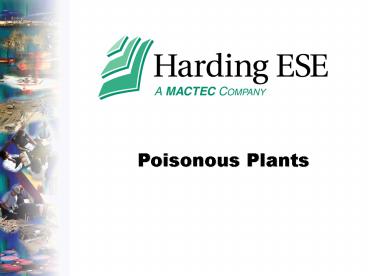Poisonous Plants - PowerPoint PPT Presentation
Title:
Poisonous Plants
Description:
Poisonous Plants Irritants - Poisonous Plants Urushiol Oil Urushiol (you-ROO-shee-ol) Main constituent of the irritant oil in plants of the Genus Toxicodendron. – PowerPoint PPT presentation
Number of Views:198
Avg rating:3.0/5.0
Title: Poisonous Plants
1
Poisonous Plants
2
Irritants - Poisonous Plants
3
Urushiol Oil
- Urushiol (you-ROO-shee-ol) Main constituent of
the irritant oil in plants of the Genus
Toxicodendron. A mixture of several compounds
which are derivatives of hydrocarbons in the C15
to C17 range.
4
Rash
- Caused by Urushiol oil
- Found in the sap
- Colorless or pale yellow
- Turns brownish-black after exposure to air.
- Oozes from any cut or crushed part of the plant,
including the roots, stems and leaves - Oil penetrates within minutes and binds with skin
proteins - Rash appears within 12-48 hours
- 2-3 weeks to heal
5
Poison IvyGenus Toxicodendron
- Types
- Woody, ropelike vine
- Trailing shrub on the ground
- Free-standing shrub
- Normally Three Leaflets
- Can vary from groups of three to nine.
- White Berries.
3 Leaflets
Waxy Cuticle
White Berries
Ropelike Vine
Berries
6
Poison Ivy
- Range (climbing vine)
- East
- Midwest
- South
- Range (shrub)
- Northern States
- Western States
- Canada
7
Identifying Poison Ivy
- Leaflets
- Usually three
- Red early spring
- Shiny green later in spring
- Red or Orange in Autumn
- Center leaf stem is longer
- Bottom leaflets opposite each other
- Usually has notched edges
- White berries close to stem, base of leaflets
8
Identifying Poison Ivy
9
Poison Oak
- Changes appearance every season
- Oak like leaves
- Three Leaflets
- Opposite lower leaflets
- Longer stem central leaflet
- Leaflets with smooth hair underneath
- White flowers
- White berries
10
Poison Oak
- Eastern variety
- Southeast
- Low shrub
- Western variety
- Pacific Coast
- 6-foot-tall clumps
- Vines up to 30 feet long
11
Poison Oak
- Leaves of three, leave them be..
12
Poison Oak - Seasons
Early Spring
Spring
Summer
Fall
Winter
Anytime
13
Poison Oak Shrubs and Vines
14
Poison Sumac
- Most common in
- Peat bogs of Northern US
- Swampy Southern Regions
- Rangy shrub up to 15 feet tall.
- 7 to 13 smooth-edged leaflets.
- Glossy pale yellow or cream-colored berries.
15
Identifying Poison Sumac
16
Prevention
- Prevention is the best treatment!!!
- Long pants, long sleeves
- Boots and Gloves
- Barrier Creams may offer some protection (e.g.,
Ivy Block) before exposure - Wash immediately (within 5 minutes) with cold
running water (stream, lake, hose)
17
Prevention
- Within the first 30 minutes, soap and water
helpful, after that. - Clean clothes, shoes, tools, etc. Oil can last
on surfaces for 1-5 years! - If working at a specific location where poison
ivy/oak/sumac is present - Wear Modified Level D (gloves, tyveks, boot
covers, etc.) - Treat plant as if it is a chemical contamination
(decon)
18
Treatment
- Over the counter
- Prescription
- Home Remedies
19
Nettles - StingersGenus Urtica
- Found in waste places and moist thickets, North
America. - Stems and leaves armed with hollow hairs
- Brittle
- Gland-tipped
- Easily broken
- If injected, liquid produces burning sensation
- Inject chemical mixture containing
- Histamine
- Acetocholine
- 5-hydrotryptamine
- Formic Acid































